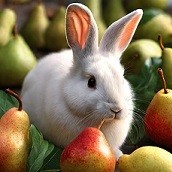Do Rabbits Eat Canegrass Hay? Diet, Safety & Nutritional Guide
Delving into Canegrass Hay
Often swaying gracefully in wetlands, Canegrass stands out with its majestic height and robust posture. This
The Verdict on Canegrass for Rabbits
Can our long-eared friends munch on Canegrass

Serving Sizes: It’s All in the Balance
Introducing Canegrass Hay into your bunny’s bowl? Start with baby steps. A modest handful, mingled with their usual hay, can strike the right chord. This gentle integration lets your rabbit savor a new taste, ensuring they don’t miss out on the more nutrient-rich hay they’re accustomed to.
Why Consider Canegrass Hay?
- Diverse Diets: Changing up the hay game can be a treat for bunnies, keeping their foraging instincts sharp.
- Fiber Galore: With a decent fiber quotient, Canegrass Hay supports a rabbit’s digestive framework. Remember, fibers are a rabbit’s digestive best friend, aiding in the prevention of gastrointestinal issues.
- A New Flavor Profile: Every now and then, a fresh taste can be an exciting culinary journey for a rabbit.
Canegrass Hay and its Nutrition (for rabbits)
| Feature | Description | References |
|---|---|---|
| Fiber Content | Canegrass hay is high in fiber, which is essential for the digestive health of rabbits. It helps to prevent gastrointestinal stasis and other digestive problems | 1, 2 |
| Protein Content | Canegrass hay has a lower protein content compared to legume hay, which is higher in crude protein, calcium, phosphorus, and magnesium. However, it still provides a good source of protein for rabbits |
2, 3 |
| Calcium Content | Canegrass hay has a lower calcium content compared to legume hay, which is higher in calcium. This makes it a good choice for rabbits that are prone to bladder stones |
2, 3 |
| Vitamin Content | Canegrass hay is a good source of vitamins A and D, which are important for the overall health of rabbits | 1, 2 |
| Nutrient Loss | Hay begins to lose its nutritional value at the time of cutting and continues to lose nutrients both while drying in the field and while in storage. The nutrients most affected by harvesting and storing are vitamins. Conversely, the protein and mineral content of hay is quite stable |
4 |
References:
- Rabbit Welfare Association & Fund – Hay Guide
- House Rabbit Society – Rabbit Diet FAQ
- The Spruce Pets – Feeding Rabbits Hay
- Poulin Grain – Q&A on Hay
Proceed, But With Eyes Wide Open
Though not harmful, Canegrass Hay doesn’t hold the title of ‘Rabbit Superfood’. Diving into new culinary waters? Be observant:
- Monitor: Keep a vigilant eye for any tummy troubles or behavior changes.
- Mix it Up: Canegrass should join the party with other hays like Timothy, not replace them.
Adding Spice to the Rabbit Diet
What’s life without a sprinkle of variety?
- Timothy Hay: A rabbit staple. Its fiber richness is unparalleled.
- Alfalfa Hay: Ideal for younger bunnies, thanks to its hearty calcium and protein levels.
- Oat Hay: Those seed heads? They’re a rabbit delicacy.
- Fruits: Berries,
tidbits (sans seeds), and banana bits can be delightful treats. Just remember: moderation is key.
A Closing Note
Every meal you place in front of your rabbit charts a course for their well-being. It’s a responsibility, yes, but also a privilege. If ever you find yourself questioning a diet choice, remember there’s a community out there, from seasoned rabbit owners to dedicated vets, ready to guide you. By remaining curious and always striving for knowledge, you’re not just feeding a rabbit, you’re nurturing a life filled with binks, flops, and pure joy.







Leave a Reply